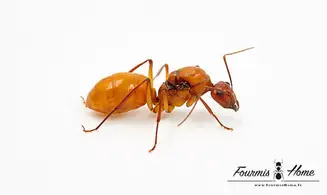



Notostigma foreli
Reference : NFOUR-005
229.90€
Available
0 in stock
Latin name: Notostigma foreli
Breeding level: Intermediate
Geographical distribution: Autralia
Habitat: Tropical forest
Colony form: Monogyne
Queen: Size: 20 - 22mm Color: Orange yellow
Workers: Size: 10 - 12mm Color: Reddish head, orange-yellow thorax and gastre
Soldier: No
Male: Size: Color:
Food: Honeydew and insectivores, such as mealworms, flies, mosquitoes, crickets etc ...
Humidity: Hunting area: 50 - 60% Nest: 60 - 70%
Temperature: Hunting area: 24-30 ° C Nest: 26-28 ° C
Hibernation: No
Nest type: Plaster tube, reconstituted stone nest or terra
Description: Magnificent rare species in breeding, very large with beautiful colors, you might think it is a big Camponotus, but it is a species that does not have a major, this species is mainly active in the evening and forms very increases the colonies.
Development: Swarming October to January
Foundation: Take place in a cloistered manner (without food) Development: 40 days from egg to worker (depending on temperature)
Size of the colony: up to 20,000 individuals, the queen can reach the age of 15 years.
Breeding level: Intermediate
Geographical distribution: Autralia
Habitat: Tropical forest
Colony form: Monogyne
Queen: Size: 20 - 22mm Color: Orange yellow
Workers: Size: 10 - 12mm Color: Reddish head, orange-yellow thorax and gastre
Soldier: No
Male: Size: Color:
Food: Honeydew and insectivores, such as mealworms, flies, mosquitoes, crickets etc ...
Humidity: Hunting area: 50 - 60% Nest: 60 - 70%
Temperature: Hunting area: 24-30 ° C Nest: 26-28 ° C
Hibernation: No
Nest type: Plaster tube, reconstituted stone nest or terra
Description: Magnificent rare species in breeding, very large with beautiful colors, you might think it is a big Camponotus, but it is a species that does not have a major, this species is mainly active in the evening and forms very increases the colonies.
Development: Swarming October to January
Foundation: Take place in a cloistered manner (without food) Development: 40 days from egg to worker (depending on temperature)
Size of the colony: up to 20,000 individuals, the queen can reach the age of 15 years.

